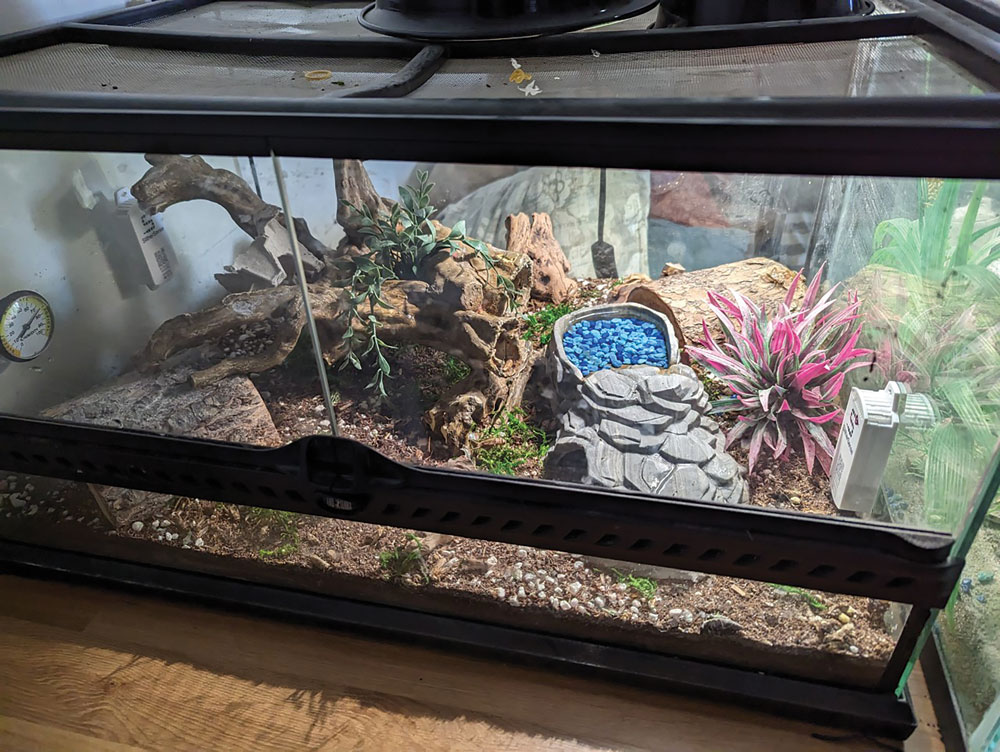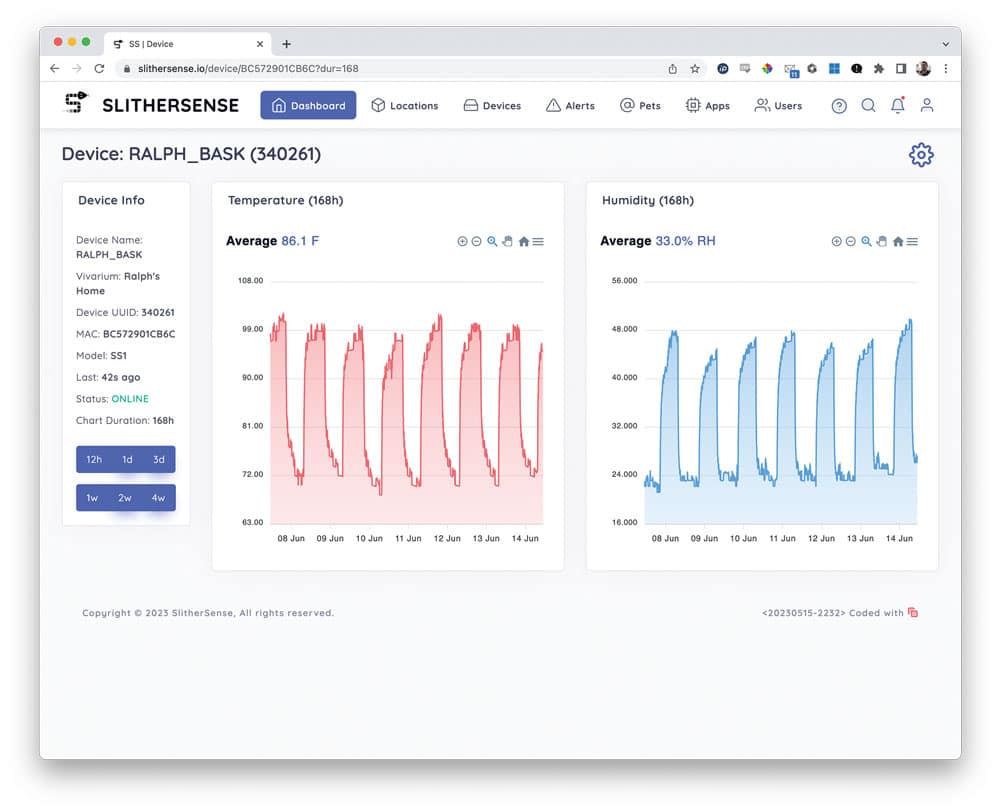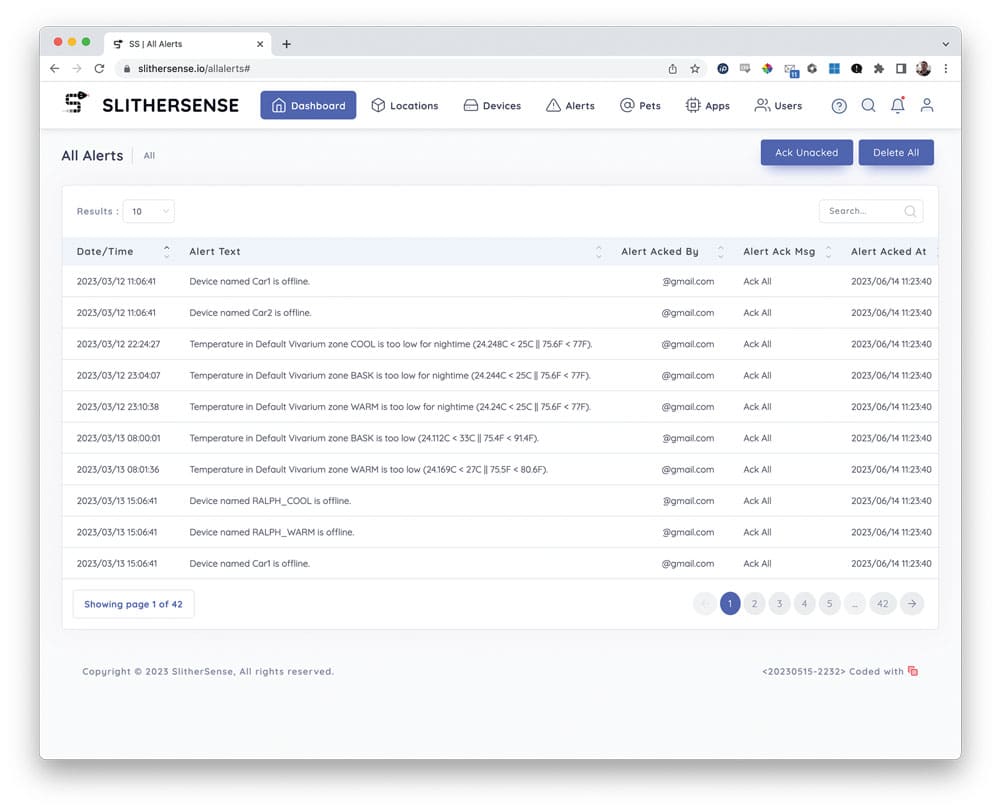Growing up in the 1970s, I have fond memories of keeping reptiles as a child. Back then, the conditions were very basic, with just a 10-gallon metal-framed aquarium and a window screen cover. But times have changed, and we now live in a world where knowledge of reptile and amphibian husbandry has grown exponentially. Along with this growth, there has been an explosion of products related to keeping these animals, such as lighting, heating, food supplements, enclosures, misting systems, and more. One of the latest frontiers in vivarium products is remote habitat monitoring technology.


The SlitherSense Vivarium Monitoring System allows for monitoring of both sides of the enclosure with two sensors.
As mentioned in one of my previous articles, I am currently in the process of updating the enclosures and related technology in my personal collection. While transitioning to modern-style vivaria has been my primary goal, I recently had the opportunity to review the SlitherSense Vivarium Monitoring System. I welcomed the chance to review this product, as I had been considering incorporating a remote monitoring feature into my setups.
As a member of Generation X, I have witnessed the incredible growth of technology over the years. While I can confidently navigate my smartphone and various electronic charting systems as a travel nurse, I have never considered myself particularly well-versed in today’s gadgets. Despite my desire for an upgrade, I must admit I was a bit apprehensive when first taking on this project.


The SlitherSense Vivarium Monitoring System displays both temperature and humidity on a single screen.
My mind was put at ease when I opened the system after receiving it. The instructions were clear and easy to follow, and the setup process was straightforward. The system comes with two sensors that can be placed on different sides of the enclosure, allowing for monitoring of temperature and humidity in different areas. This is especially useful for larger enclosures or those with varying temperature and humidity levels.
The SlitherSense system also has a mobile app that allows for remote monitoring and control. This feature is particularly helpful for those who travel frequently or have multiple vivaria to monitor. The app displays real-time data and allows for adjustments to be made to the temperature and humidity settings.
Overall, I was impressed with the SlitherSense Vivarium Monitoring System. It is a valuable tool for any reptile or amphibian keeperRewritten Article:
When the SlitherSense remote monitoring system arrived in the mail, I was immediately impressed by its compact packaging and simple design. The package contained two pieces of hardware and a charger cord, but no brick was included. According to the instructional video, this decision was made to reduce costs and because most households already have extra bricks lying around.
Installation instructions can be found on the company’s website, www.slithersense.com. The system consists of a gateway monitor and a sensor, with one sensor needed for each zone depending on the enclosure size. To register the device and monitor readings, the SlitherSense app must be downloaded on a smartphone. This app can also be used for real-time monitoring without having to visit the website. The sensors are designed to be attached to smooth surfaces such as glass or plastic, with rivet holes for screwing into wood if necessary. However, I did notice that the white color of the sensor stands out in naturalistic enclosures. The sensor itself measures 8.89 cm x 3.81 cm x 1.9 cm (3.5 in x 1.5 in x 0.75 in) and can be easily camouflaged if desired.
I selected five enclosures for sensor placement, ranging from a 121.9 cm × 60.9 cm x 60.9 cm (4 ft x 2 ft x 2ft) lounge enclosure housing a bearded dragon (Pogona vitticeps) to a 37.8 liter (10 gallon) enclosure in our reptile room housing a young Florida banded watersnake (Nerodia fasciata pictiventris). The remaining sensors were placed in various enclosures in our reptile room, including a paludarium with crocodile newts (Tylototriton kweichowensis) and freshwater shrimp (Neocaridina davidi), an open-air screened enclosure with Mexican alligator lizards (Abronia gramenia), and a more arid vivarium with leopard geckos (Eublepharis macularius). Instead of naming my animals, I simply named the species in each enclosure. The sensors read two to three zones depending on the size of the vivarium, with enclosures under 75.7 liters (20 gallons) divided into two zones (bask and cool) and larger enclosures divided into three zones (bask, warm, and cool).
Once installed, temperature and humidity readings are immediately available. However, there were a few initial hiccups with the process. When the Gateway unit was placed in the living room next to the bearded dragon enclosure, I received email alerts stating that three sensors in the reptile room were offline for a period of time. This issue continued intermittently until I moved the module to the reptile room with the other sensors. The company was quick to communicate and resolve these glitches.
The app is designed to organize however many vivariums are being monitored by breaking them down into locations, such as the reptile room or living room. Each enclosure is considered a device, and according to the founder, the system can handle even large zoos with multiple buildings as long as the environments are logically organized. Storage units can also be monitored, but they do not have temperature zones and only have a single temperature and humidity reading that all devices assigned to that unit are responsible for monitoring. For example, a refrigerator or freezer storing food could be monitored using this system. The SS1 sensor units are capable of measuring temperatures between -40 degrees Celsius and 70 degrees Celsius with a 0.3 degree accuracy. While there may not be a reptile that requires a 70 degree Celsius basking spot, this wide temperature range makes the system suitable for monitoring other purposes, such as storage.
In conclusion, the SlitherSense remote monitoring system is a convenient and versatile tool for monitoring temperature and humidity in reptile enclosures. Its compact design and easy installation make it a great option for both hobbyists and professionals alike. With the added feature of real-time monitoring through the app, it provides peace of mind for reptile owners and can even be used for other purposes such as monitoring storage units..com/wp-content/uploads/2023/12/slithersense-email-alert.jpg 1000w, https://reptilesmagazine.com/wp-content/uploads/2023/12/slithersense-email-alert-400×324.jpg 400w, https://reptilesmagazine.com/wp-content/uploads/2023/12/slithersense-email-alert-650×527.jpg 650w, https://reptilesmagazine.com/wp-content/uploads/2023/12/slithersense-email-alert-250×203.jpg 250w, https://reptilesmagazine.com/wp-content/uploads/2023/12/slithersense-email-alert-768×623.jpg 768w, https://reptilesmagazine.com/wp-content/uploads/2023/12/slithersense-email-alert-150×122.jpg 150w, https://reptilesmagazine.com/wp-content/uploads/2023/12/slithersense-email-alert-800×649.jpg 800w” src=”https://reptilesmagazine.com/wp-content/uploads/2023/12/slithersense-email-alert.jpg” data-sizes=”(max-width: 1000px) 100vw, 1000px” class=”wp-image-122523 size-full lazyload”/>
E mail alerts on the SlitherSense Dashboard.
One of the main features of SlitherSense is the ability to monitor and track the temperature and humidity levels in your pet’s vivarium or terrarium. This can be done for any type of container, making it a versatile tool for reptile and amphibian owners. The platform allows for individual animals to be named and includes options for adding their species, Wikipedia link, notes, birthdate, and icons. However, the list of species to choose from for the animal type can be overwhelming and seemingly random. While it includes common species like leopard geckos and corn snakes, it also includes rare and exotic species found only in specialist collections or zoos. The founder has stated that they plan to add a “Request a Pet Type” button in the future to address this issue.
In addition to monitoring temperature and humidity, SlitherSense also offers a calendar and to-do list feature, which is still in the process of being implemented at the time of writing. The platform also allows for customization of climate settings, with the option to input specific needs for your pet.
One unique aspect of SlitherSense is its email alert system, which notifies users if the temperature or humidity levels in their pet’s enclosure fall outside of the desired range. This can be especially helpful for owners who may be away from home for extended periods of time.
Overall, SlitherSense offers a user-friendly and customizable platform for monitoring and tracking your pet’s vivarium or terrarium. With the addition of new features and improvements, it has the potential to become an essential tool for reptile and amphibian owners.The author of this article, Nick Garner, collaborated with his three sons, Ren, Ryo, and Rei, to create a unique project inspired by their bearded dragon, Ralph. According to Garner’s website, the goal was to engage his sons’ interest in building things.
As this was my first experience with a remote monitoring system, I had no previous comparisons to make. A quick Google search only yielded a few similar products. The price point for the Two Zone Package, which includes one SS Gateway and two SS1 temperature/humidity sensors, is reasonable at USD $95.99. These products can be purchased online through an Amazon.com store.
The website states that “Accounts start with enough credits to run for free, for years,” and adds, “After that, pay for what you use. We will never charge a recurring subscription.” I reached out to the company for clarification on this and was informed that credits are used to cover costs for services such as sending emails, texts, or storing data for extended periods. The company emphasized that with proper tuning of the settings, it is possible to run the system for years at no cost. It was further explained that whenever credits are depleted, the user can purchase more to top up the account. Users will be notified when credits are running low, and features that consume a credit will stop functioning. It is important to note that regardless of credit status, the ability to view current temperature settings will never be affected.
Overall, the SlitherSense Vivarium Monitoring System is well worth its reasonable price. Despite a few minor discrepancies at the beginning, the system has been functioning well for several months now. The ability to monitor temperature and humidity readings on a smartphone is a particularly positive aspect for those like myself who work out of town and may not be able to physically check on enclosures for days at a time. If you only have one or two vivariums housing hardy species, the SlitherSense system may not be considered an essential piece of equipment, unless you enjoy gadgets and want to add all the bells and whistles. However, the system truly shines for serious hobbyists and breeders who maintain multiple enclosures, or for those who have a few vivaria housing delicate species.
Remote monitoring systems are the next step in herpetoculture and should definitely be considered by anyone serious about the welfare of their animals.


Wow, this sounds like a game-changer for reptile enthusiasts! Can’t wait to learn more about the SlitherSense Vivarium Monitoring System.